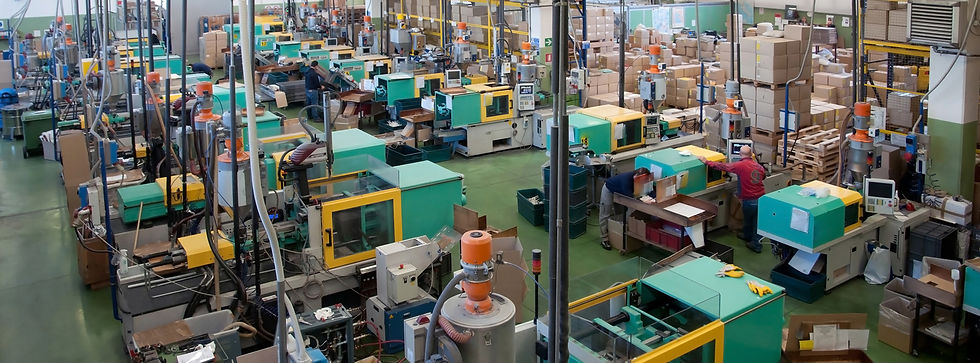Injection Molding Tools: 7 Tips to Get the Tooling Right
- MP Webmaster

- May 19
- 4 min read
Getting a plastic part manufactured isn't just about CAD files and material selection—your success often hinges on one thing: the mold. At Moraine Plastics, we’ve seen firsthand how the right tooling decisions can save months of headaches… and how the wrong ones can derail a great idea.
If you’re sourcing a tool for the first time—or even the fiftieth—here are seven tips to help you get it right from the start.

1. Cavitation Isn’t Just a Buzzword—Get It Right Early
One of the first questions we ask clients is: How many parts do you need—and how fast? That’s where cavitation comes in. A single-cavity mold might be perfect for tight-tolerance prototyping. But if you’re looking at high-volume production, multi-cavity tools can crank out parts faster and lower your per-unit cost.
That said, more cavities mean more complexity. It’s not always worth it. The trick is knowing the trade-offs—and that’s where a conversation with an experienced molder (like us) pays off early.
2. Ask What the Injection Molding Tool Is Made Of—Not All Steel Is Equal
Tooling isn’t a one-size-fits-all situation. Aluminum molds are great for short runs or fast iterations. Steel tools? Better for long production cycles and demanding materials.
But even among steel tools, there’s a range. We’ve had customers come to us with quote comparisons where the “cheaper” option was using subpar imported steel that wouldn’t last half as long. Spoiler: They ended up paying twice.
At Moraine Plastics, we’re transparent about the materials we spec and why. Ask your molder—what kind of steel are they using? What heat treatments? If they can’t answer quickly, that’s a red flag.
3. Don’t Sleep on Gate and Runner Design
Gate placement, runner size, cooling channels—it might sound like backend stuff, but it has a huge impact on part quality and cycle time. Improper gating can cause sink marks, warping, or uneven fill. Poor cooling? Get ready for long cycle times and higher cost per part.
Our engineers at Moraine Plastics think about these factors during the design phase—not as an afterthought. We’ll walk you through how your part will fill, cool, and eject before a single chip is cut.
If your molder isn’t bringing this up early, ask why not.
4. Tooling is a Partnership—Don’t Go It Alone
We can’t say this enough: Bring your molder in early. We’ve had projects land on our desk where we were asked to quote a tool designed in a vacuum—zero input on draft angles, wall thickness, or material flow. That’s like designing a race car without talking to the mechanic.
At Moraine, we offer Design for Manufacturability (DFM) support upfront. Whether you have a finished CAD model or just a sketch on a napkin, our team can help you avoid costly rework down the road.
“We don’t just build molds—we help customers avoid bad decisions,” says Gerry Ford, owner of Moraine Plastics. “A lot of headaches can be prevented just by having a five-minute conversation early in the process. That’s something we always offer.”
5. Beware the Low-Cost Tooling Mirage
Everyone wants to save money—we get it. But tooling is one of those areas where cutting corners can backfire fast. We’ve seen tools sourced overseas that were missing cooling lines or built with soft steel that wore out in the first production run.
If you’re getting a quote that’s way below the others, ask what’s being left out. Sometimes that “great deal” turns into delays, quality issues, and a second round of tooling.
With Moraine Plastics, you’re not just paying for a tool—you’re paying for experience, honesty, and tools that work the way they’re supposed to. We stand behind our work, every step of the way.
6. Plan for Tool Maintenance and Lifecycle
A good mold isn’t just built—it’s maintained. We always encourage customers to think beyond the first production run. Will the tool run for 100,000 cycles or a million? How often does it need to be serviced? Who handles repairs?
At Moraine Plastics, we track tool performance and proactively schedule maintenance to keep your production running smoothly. A tool is an investment—treat it like one, and it’ll pay you back over time.
7. Think About Future Part Revisions—Design for Flexibility
Changes happen. Maybe a cosmetic tweak, maybe a dimensional update. But not all tools are built with revisions in mind. Small oversights in tooling design can make simple changes expensive or even impossible later.
When you work with Moraine, we build with adaptability in mind—especially for parts that might go through early-market iterations or feedback cycles. You don't always need to start over when the market evolves.
Final Thoughts
Getting the tooling right is one of the most important decisions in any plastic injection molding project. It affects your timelines, your costs, and the quality of every part you produce.
At Moraine Plastics, we help customers get it right every day—from startups launching new products to Fortune 500s scaling complex assemblies. If you're planning a new project and want a tool that’s built to perform, let’s talk.
Ready to build it right?
👉 Contact us at moraineplastics.com to start your next project.



